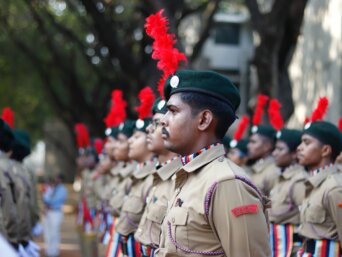- About
- Topics
- Picks
- Audio
- Story
- In-Depth
- Opinion
- News
- Donate
- Signup for our newsletterOur Editors' Best Picks.Send
Read, Debate: Engage.
| topic: | Political violence |
|---|---|
| located: | India, Pakistan, Afghanistan, Sri Lanka |
| editor: | Shadi Khan Saif |
After decades of struggling to defeat poverty, India has made steady advances following a series of smart political choices; but it is still far behind in ensuring its eradication, and the hawkish trend of military spending will not help or address the issue, to say the least.
Prime Minister Narendra Modi last week oversaw the commissioning of the first Indian-designed and constructed aircraft carrier, the multi-million dollar INS Vikrant. The country is also set to receive the multi-billion dollar Russian missile system soon, among other similar ambitious moves.
Meanwhile, there are towns and villages in India where people are still struggling for food and water. What is the need and purpose of these investments when there are hundreds of other avenues to spend these funds for the welfare of the Indian people or for greater good to the entire region?
This strange investment comes at a time when the world is witnessing the expansion of polarisation to new dangerous levels. Any misadventure or calculation error in South Asia could unleash a calamity that might not be controlled in time. Among the many genuine geo-strategic lessons to be learned from the latest Russia-Ukraine conflict is that the accumulation of arms and militarisation of politics dangerously leads to war and destruction.
India and Pakistan, as two major countries armed with nuclear weapons, have been wasting their potential for a bright shared future that could even bring peace and harmony to neighbouring Afghanistan or stability to Iran and Sri Lanka. The devastating impacts of the arms race are clearly evident in Pakistan, where the powerful army has held the entire state machinery hostage to the idea of India being a 'sworn enemy'. With the political direction in New Delhi, one fears the same attitude toward Pakistan in India would be extremely unfortunate.
While both countries have spent enormous amounts of wealth and energy on developing nuclear arsenals to threaten each other, Pakistan has been begging for international funds to avert defaulting on its debts. Does India want to follow suit by prioritising military spendings?
Last month, India, Pakistan and Afghanistan celebrated their respective independence days, but these three countries in the South and Central Asian region have remained engulfed in bitter conflicts with each other for decades.
India sees Pakistan as its arch rival, Afghanistan has long been frustrated with Pakistan for its alleged interference and cross-border terrorism while Pakistan sees itself caught between both of its ‘enemies’. This enmity, lingering on since the end of British rule in the 20th century, has hardened and become more poisonous over the years.
The citizens of Afghanistan, India and Pakistan need to thoroughly study the history of revanchism between Germany and France, which led to devastating wars, but was later converted into the foundation for European integration. The key to success of the historic Élysée Treaty of friendship between France and Germany signed in 1963 was mutual respect and close consultation between Berlin and Paris on all important issues.
Without wasting more time, opportunities or energy, India needs to take the lead as a major power in the region to switch the tides of militarisation and move towards mutual cooperation for the greater good of its nearly two billion citizens.
Photo by Mukesh S

